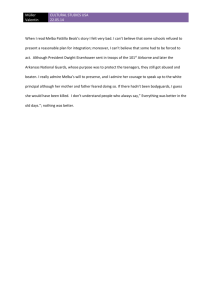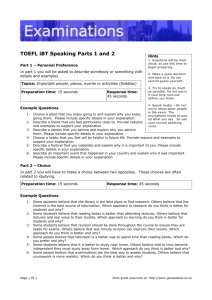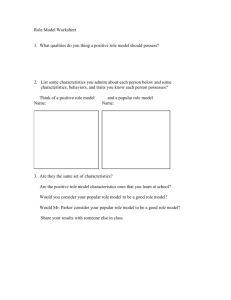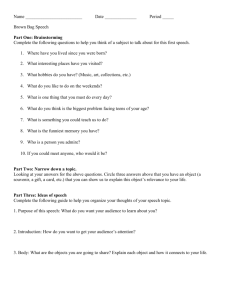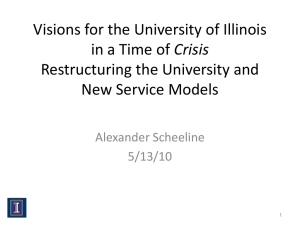EVALUATION OF ADMIRE GROWTH ENHANCEMENT IN TOMATO AND PEPPER
advertisement
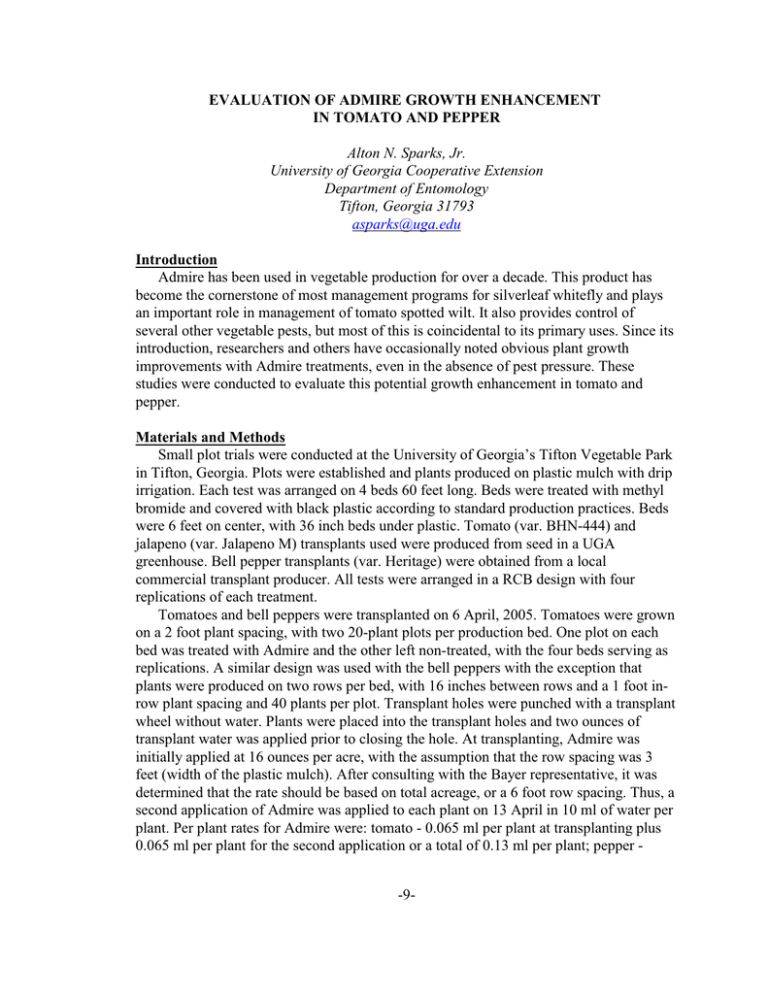
EVALUATION OF ADMIRE GROWTH ENHANCEMENT IN TOMATO AND PEPPER Alton N. Sparks, Jr. University of Georgia Cooperative Extension Department of Entomology Tifton, Georgia 31793 asparks@uga.edu Introduction Admire has been used in vegetable production for over a decade. This product has become the cornerstone of most management programs for silverleaf whitefly and plays an important role in management of tomato spotted wilt. It also provides control of several other vegetable pests, but most of this is coincidental to its primary uses. Since its introduction, researchers and others have occasionally noted obvious plant growth improvements with Admire treatments, even in the absence of pest pressure. These studies were conducted to evaluate this potential growth enhancement in tomato and pepper. Materials and Methods Small plot trials were conducted at the University of Georgia’s Tifton Vegetable Park in Tifton, Georgia. Plots were established and plants produced on plastic mulch with drip irrigation. Each test was arranged on 4 beds 60 feet long. Beds were treated with methyl bromide and covered with black plastic according to standard production practices. Beds were 6 feet on center, with 36 inch beds under plastic. Tomato (var. BHN-444) and jalapeno (var. Jalapeno M) transplants used were produced from seed in a UGA greenhouse. Bell pepper transplants (var. Heritage) were obtained from a local commercial transplant producer. All tests were arranged in a RCB design with four replications of each treatment. Tomatoes and bell peppers were transplanted on 6 April, 2005. Tomatoes were grown on a 2 foot plant spacing, with two 20-plant plots per production bed. One plot on each bed was treated with Admire and the other left non-treated, with the four beds serving as replications. A similar design was used with the bell peppers with the exception that plants were produced on two rows per bed, with 16 inches between rows and a 1 foot inrow plant spacing and 40 plants per plot. Transplant holes were punched with a transplant wheel without water. Plants were placed into the transplant holes and two ounces of transplant water was applied prior to closing the hole. At transplanting, Admire was initially applied at 16 ounces per acre, with the assumption that the row spacing was 3 feet (width of the plastic mulch). After consulting with the Bayer representative, it was determined that the rate should be based on total acreage, or a 6 foot row spacing. Thus, a second application of Admire was applied to each plant on 13 April in 10 ml of water per plant. Per plant rates for Admire were: tomato - 0.065 ml per plant at transplanting plus 0.065 ml per plant for the second application or a total of 0.13 ml per plant; pepper -9- 0.016 ml per plant at each application or a total of 0.032 ml per plant. These rates should represent 16 oz of Admire 2F with assumed plant densities of 3630 tomato plants per acre and 14520 pepper plants per acre. The jalapeno pepper test was established similar to the bell pepper test (same row spacing and plant spacing), with the exception that individual plots were 30 plants (two rows of 15 plants) and three plots were established on each bed to accommodate three treatments. Treatments evaluated were Admire at 16 ounces per acre, Platinum at 8 ounces per acre, and a non-treated control. Insecticides were applied based on total acreage (6 foot rows, or 14520 plants per acre) with the full treatment applied in 2 ounces of transplant water per plant as previously described. Per plant application rates were 0.0326 ml of Admire 2F and 0.016 ml of Platinum 2F. Jalapeno plants were transplanted on 15 April, 2005. To evaluate direct plant growth response, plant heights were measured on 10 plants per plot in the tomato and bell pepper tests on 9 and 18 May. On 18 May, the number of blooms present on 10 plants per plot was also counted in the tomato test. Tomatoes were harvested a single time because of disease problems developing in the test (Southern blight was beginning to kill individual plants). Plots were harvested on 15 June. Eight ‘healthy’ plants were harvested in each plot. All fruit were removed from the harvested plants and classified has mature, immature or diseased (mostly fruit rots). The mature fruit were counted and weighed. Immature fruit and diseased fruit were weighed. The entire plot was harvested for bell pepper yields, with only mature fruit harvested on each date. For the first harvest, fruit were counted and weighed. On subsequent harvests, fruit were classified based on presence or absence of disease on the fruit and counted and weighed. Data were analyzed for number, weight and average weight per pod for each harvest date and total harvests. Jalapeno peppers were adversely effected by transplanting; thus, at the first harvest, plants in each plot were categorized as small, medium or large and counted. Fruit were harvested from the entire plot. For the first two harvests, pods from each plot were counted and weighed. On the final harvest, fruit were not counted but weighed. Data were analyzed for number, weight and average weight per pod for each harvest date and total harvests (with the exception of the last harvest were number of pods was not collected). Yields were also evaluated after adjustment to a per plant basis for large and medium plants only. Data for the tomato and bell pepper tests were analyzed with the PROC TTEST procedure of PC-SAS. Data for the jalapeno test were analyzed with the PROC ANOVA procedure. Where significant differences were detected (P<0.05), means were separated with LSD (P=0.05). Results and Discussion No significant difference were detected in tomato or bell pepper plant heights (Table 1). Also, no differences were detected in the number of blooms per plant in tomatoes. Disease incidence on fruit in tomatoes was fairly low and treatment showed no effect, so only total harvest data is shown (Table 2). A strong trend (statistical significance of P -10- > 0.05 but P < 0.1) for increased number and weight of mature fruit at first harvest (only harvest in this test) with the Admire treatment was detected. A numerical trend for increased yield with Admire treatment also appeared in total pounds of fruit harvested. Disease incidence in bell peppers was also fairly low and treatment showed no effect, so only total harvest data is shown for each date (Table 3). Both number and weight of fruit harvested did not significantly differ between treatments on any date or for the total yield. Furthermore, the slight trends in the data favor the untreated control on three of the four harvest dates. In the jalapeno test, no significant differences occurred in the number of plants per plot (Large, medium, small, or total). No significant differences were detected in pepper yields in any of the data, either for total plants (Table 4) nor adjusted for large and medium plants (data not presented). The only consistent trend was for slightly lower yields in the Platinum treatment, but this was not statistically significant. Use of Admire did not significantly enhance plant growth or yield in tomatoes or pepper in these tests, although, a strong trend for increased yield was detected on tomatoes. On the other hand, growth and yield differences have been occasionally detected with Admire treatments in the absence of any obvious pest control that would explain these differences. I have seen extremely obvious increase in plant size in tomato with Admire treatments in the absence of pest pressure. More frequently, I have experienced little or no growth enhancement in the absence of pests. While it is obvious that growth enhancement can occur with Admire, the conditions which allow or prevent this growth enhancement are not understood. Until this plant response is better understood and can be manipulated to the growers advantage, Admire should only be used for pest control when needed and any growth enhancement that may occur considered an unexpected benefit. Plants in these tests were fertilized and watered regularly and were never exposed to excessive stress (with the possible exception of the jalapeno peppers which experienced severe transplant stress). Given the recent interpretation that Admire may provide some stress protection rather than a direct growth effect, the lack of differences would support a lack of direct growth enhancement. Table 1. Average plant heights, Admire growth enhancement test, Tifton, Georgia, 2005. Average height of plants (Inches) Treatment Check 5/9 5/18 5/9 5/18 Tomato Blooms per Plant on 5/18 9.80 14.2 21.14 28.00 10.3 28.11 10.9 Bell Pepper Plants Tomato Plants Admire 9.39 13.7 21.83 No significant differences were detected (TTEST, P=0.05). -11- Table 2. Tomato yield per plot, Admire growth enhancement test, Tifton, Georgia, 2005. Treatment Check Mature Fruit (Good Quality) Number Pounds Pounds of immature fruit (Good quality) 51.0 * 22.84* 40.35 Admire 73.0 33.38 41.48 No significant differences were detected (TTEST, P=0.05). * Differences were significant at P = 0.1. Pounds of diseased fruit Pounds of fruit (Total) 12.25 75.44 12.25 87.10 Table 3. Bell pepper yield per plot, Admire growth enhancement test, Tifton, Georgia, 2005. Treatment Yields per plot 6/9 6/14 6/22 6/28 Total Number of pods per plot Check 18.50 38.50 107.25 49.25 213.50 Admire 16.25 35.00 111.50 48.25 211.00 12.98 38.35 17.20 75.26 17.19 75.94 Pounds of pods per plot Check 6.74 Admire 6.00 12.00 40.76 No significant differences were detected (TTEST, P=0.05). Table 4. Jalapeno pepper yield per plot, Admire growth enhancement test, Tifton, Georgia, 2005. Treatment Number of pods per plot Pounds of pods per plot 6/23 6/30 6/23+6/30 6/23 6/30 7/19 Total Check 165.25 211.75 377.00 6.89 7.74 13.15 27.77 Platinum 142.75 182.25 325.00 5.97 6.76 9.67 22.40 Admire 175.00 199.25 374.25 6.91 7.10 No significant differences were detected (ANOVA, P=0.05). 13.78 27.78 -12-
